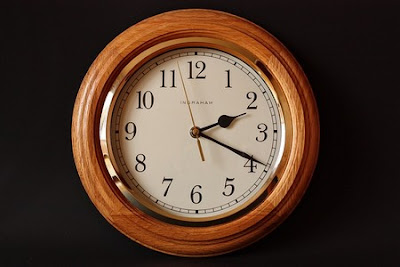Time card math can be confusing but it sure can come in
handy. Some companies have you keep your own time and then turn it in where you
manager okays it. There are times when you look at your paycheck and the hours
do not seem right. Knowing how to do time card math can really be handy. Even if
you just want to keep track of your hours per pay period, time card math will
help.
There are several reasons you might need to check your time card or paycheck, or keep track of the exact amount of hours and minutes you have worked in a pay period.
Copyright © October 2011 Sam Montana
There are several reasons you might need to check your time card or paycheck, or keep track of the exact amount of hours and minutes you have worked in a pay period.
Some companies are now having their employee keep track of
their own time and then entering this into the computer so some other company
can print the paychecks. Or maybe you don’t trust the pay you received and need
to figure out the exact hours you worked from your time cards.
I can’t tell you how many times over the years I have had to
use time card math to check time cards and paychecks for myself and others. It
can get confusing though. For example, you are in to work at 8:00 AM and out at
5:25 PM.
Step 1: The first
thing you have to do is convert the time to a 24 hour clock instead of the
normal 12 hour clock. To do this, you have to add 12 to the hour after noon. In the above example you would add 12 to 5 PM, going into work at 8 AM and leaving at 17:25 in the afternoon. You can then know for that day
you worked 9 hours and 25 minutes (17 – 8 = 9 hours). You will also have to
subtract a lunch break if needed.
Let’s take a look at a typical 5-day work week:
- Monday – In at 9 AM and leave work at 4:50 PM (12 + 4 PM = 16). You left work at 16:50 which is 7 hours and 50 minutes worked (16 – 9 AM = 7 hours plus the 50 minutes).
- Tuesday – 7 hours 55 minutes
- Wednesday – 8 hours and 10 minutes
- Thursday – 8 hours and 20 minutes
- Friday – 9 hours and 30 minutes worked
Add up the hours and minutes and you get 39 hours and 165
minutes. That doesn’t work very well if you want to know exactly how many hours
and minutes you worked.
Step 2: Since
there are 60 minutes in an hour, you have to convert the minutes into 100ths.
To do the time card math, you take the minutes and divide them by 60 which turns
the hours and minutes into numbers you can actually use.
In the above example you would divide the 165 minutes by 60
which equals 2.75 (165/60 = 2.75). You then add the 2.75 to the 39 hours for a
total of 41.75 hours worked.
With this number, you can now do meaningful math. You can
see that you worked 1.75 hours overtime and you can also figure your actual pay
properly.
To convert this number into hours and minutes, you take the
.75 minutes and multiply it by 60, which equals 45 minutes (.75 x 60 = 45). You
worked 41 hours and 45 minutes for that week
With this time card math information, you can now know
exactly how many hours and minutes you have worked each pay period, whether you
keep track of your hours yourself or need to check your time cards.
Here is a quick and handy reference:
- 15 minutes = .25 (15/60 = .25) or .25 = 15 minutes (.25 x 60 = 15)
- 30 minutes = .50 (30/60 = .50) or .50 = 30 minutes (.50 x 60 = 30)
- 45 minutes = .75 (45/60 = .75) or .75 = 45 minutes (.75 x 60 = 45)


Time card math is important to prove your point to your boss if the time should ever come where you believe your pay is short.
ReplyDelete